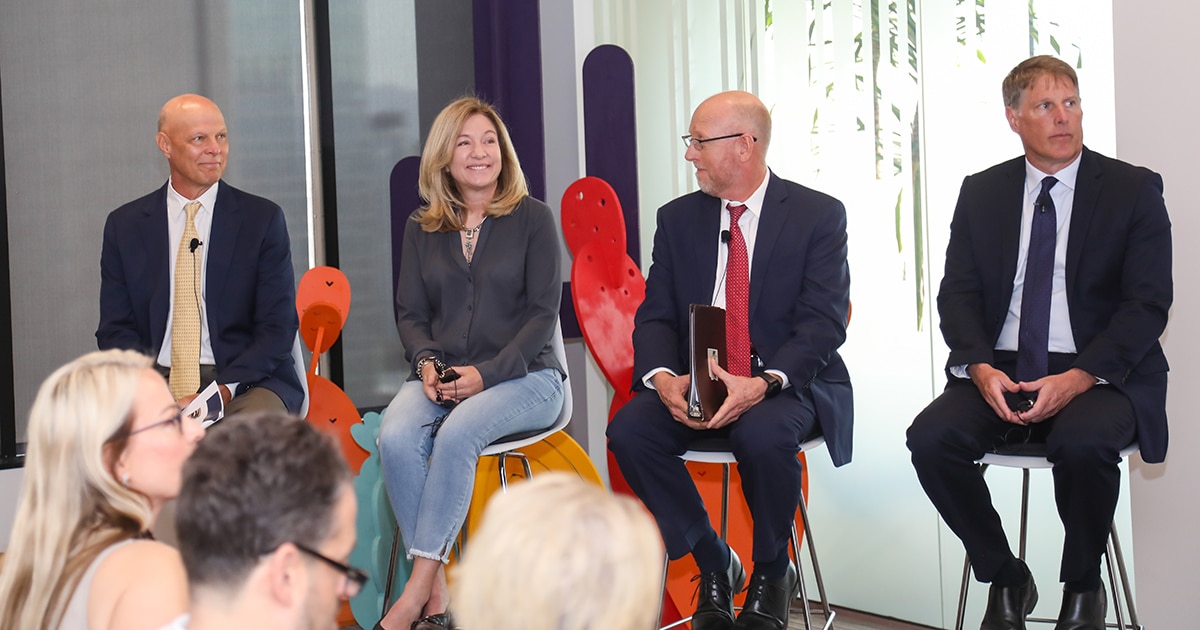

Ambassador Event: Dispelling the Myths of Arizona’s Water Position
Published: 09/27/2023
Reviewing facts and misconceptions of Arizona water
Though Greater Phoenix is situated in a desert, the region was cultivated carefully throughout generations with access to water in mind. Indigenous tribes created agricultural-based civilizations around the areas where the three main rivers converge. Construction on the Central Arizona Project (CAP) canals began before Arizona even earned statehood. The Groundwater Management Act of 1980 laid the foundation for modern regulations seen today.
Water has always been stewarded by Arizonans, and leaders recognize the importance of this essential resource in life and business. As concerns over the Colorado River and other southwest water sources rear, Greater Phoenix and Arizona are ahead of the game in planning for the future.
Public and private leaders joined the Greater Phoenix Economic Council (GPEC) on a panel to discuss Arizona’s water situation. The panel consisted of:
- David Beckham, Chairman of the Board, Water Infrastructure Finance Authority of Arizona
- Kathryn Sorensen, Director of Research, ASU Kyl Center for Water Policy
- The Hon. Eric Orsborn, Mayor, City of BuckeyeAaron Blawn, Corporate Services Site Manager, Intel Corporation
- Moderator: Kevin Carranza, Senior Director of Business Intelligence, Greater Phoenix Economic Council
The group addressed a variety of myths and misconceptions about Arizona water.
Myth: Arizona is out of water
Arizona is not out of water. Between the Colorado River, groundwater, reservoirs, rivers, reclaimed water and other surface water, the state has a myriad of resources. The reason this misconception has garnered attention recently is in large part due to the reaction of a groundwater report released by the Arizona Department of Water Resources (ADWR) in June that showed a 4% shortage of groundwater, about 4.9 million acre-feet, over the next 100 years. The state began to pause approvals of new assured water supply certificates that rely on pumping groundwater, but existing approvals of more than 80,000 lots were not affected.
It is vital to regulate this water usage because groundwater does not renew naturally and annually, so it must not be depleted. The water is replenished with help from the Colorado River.
“Groundwater is our nest egg,” Sorensen said. “Groundwater is the reason that we are here today, and its successful management is the reason why people will be able to live here 100 years from now.”
While the Colorado River shortage declaration impacted overall water use, the state is less reliant on the river than its southwest neighbors. Only 36% of Arizona’s water comes from the Colorado River. The City of Phoenix, for instance, gets more than 60% of its water from the Salt and Verde rivers.
“There is a lot of water here, but of course we have to manage it sustainably so that future generations can enjoy the same quality of life,” Sorensen said.
Myth: Buckeye cannot build more housing
Since 2000, Buckeye has grown from a population of 6,500 to 114,000 across 640 square miles. With that fast growth has come a massive business boom and increased housing needs. Buckeye is in the Phoenix active management areas (AMAs), one of six AMAs in which new subdivisions must prove they have a 100-year water supply.
Buckeye can and is continuing to build houses. All projects that have been issued certificates for the assured water supply have continued to develop, and the city must provide changes to water management strategies to show the Hassayampa sub-basin will still be at its required water level in 100 years.
Orsborn said the ADWR’s Hassayampa Sub-Basin Report was based on 2016 data, so it did not account for additions that have already been made to the Buckeye water portfolio including the acquisition of 2,000 acre-feet a year (AFY) of Non-Indian Agriculture water rights, approval of a purchase agreement for 5,926 more AFY, and recharge 2,500 AFY of effluent annually. The city has also implemented a drought management plan and conservation codes.
In 2022, Buckeye issued 2,100 single-family permits and 1,900 multifamily construction permits. Another 2,700 multi-family permits are in the review process.
“We have a very balanced portfolio of housing and are looking to grow that in the future,” Orsborn said.
Myth: Industry is using all the water
While Greater Phoenix’s manufacturing boom is bringing high-quantity water users to the region, industrial usage has a relatively small impact on overall water use. Only 6% of total water goes to industrial users while the rest is for residential and agriculture. Arizona’s water usage is at 1957 levels, despite GDP being nine times higher today and population more than six times higher.
Some of the best water stewards in the state are industrial users. Intel is a prime example, as its 12-acre water recycling and treatment facility and brine reduction facility in partnership with the City of Chandler can treat nearly 13 million gallons of water a day. The company achieved net-positive water use in 2022, eight years ahead of its goal, and restores and returns more water than it uses.
The company’s Ocotillo campus this year earned a Platinum Certification from the Alliance for Water Stewardship (AWS), making Intel the first semiconductor company to receive the AWS’ highest level of certification.
“Intel has always had an incredibly high bar on sustainability,” Blawn said.
Intel’s water reclamation projects are similar to that of many cities in the regions that have reclaimed water systems. The majority of large Arizona wastewater treatment plants distribute reclaimed water for reuse, according to a University of Arizona study. The Water Infrastructure Finance Authority of Arizona (WIFA) has provided grants to reclamation use throughout the state.
“Some of the infrastructure that’s really critical for water that I think is relatively unique to here is the reclaim water infrastructure,” Blawn said. “As much as we can use that reclaimed water over again, that’s just the circular water economy.”
Myth: Arizona has not dedicated funding to water planning
Throughout the history of the state, Arizona has devoted money and energy to water. The 336-mile CAP canal system is the capstone of the area and has been a key driver of business and population growth over the last 100 years.
WIFA actively manages five different funds, two of which have been in place for decades. The Clean Water and Drinking Water funds, which provide loans and technical assistance for wastewater and stormwater projects and public water systems infrastructure, have provided nearly $3 billion in loans and $102 million in forgiven principal since 1989.
WIFA also has a $200 million Water Conservation Grant Fund for water users, another $200 million Water Supply Development Revolving Fund for areas outside urban zones, and manages the $1 billion Long-Term Water Augmentation Fund designed to import water.
While water importation will likely play a role in the future of Arizona’s water portfolio, it will be significantly more expensive than traditional water sources, Beckham said. WIFA is in the process of creating a framework with input of water providers based on how much imported water is needed and the timeframe of receiving it.
“Once we know from the water suppliers … we will unleash that framework to gain all the ideas and all the programs and then we can choose from the best ideas,” he said.
Myth: Arizona is not planning for the future
Precautions surrounding Arizona water usage today are evidence that the state is planning for the future. There is sufficient water today; the measures taken by cities not to exhaust groundwater and river supply indicate that the forward-thinking state is prepping for not just today and tomorrow but the days and years to follow.
WIFA’s five-year strategic framework centers on the $1 billion already invested in augmentation, $400 million invested in conservation and additional money for new loans and grants.
Intel has funded 20 water restoration projects in partnership with city, nonprofit and Native American communities that, once fully implemented, will restore nearly 2.2 billion gallons of water annually.
Leaders are also looking toward desalination, though Beckham said that it is still years away from coming to fruition.
“I don’t see it immediately,” Beckham said. “But it’s clearly a technology that works. It is one that we are looking at. Whether it’s from Mexico [or] California, it’s going to happen at some point in the future.”
Greater Phoenix is in a good position, but for Arizonans of the future to live with the water comfort residents today are accustomed to, more work must be done including potential expansion of reservoir capacity and the development of augmentation and importation, which Sorensen thinks is necessary.
“I am personally very optimistic about our water future,” she said. “There is a lot that we can do with the power of human innovation and adaptation, and infrastructure mitigates variability.”
Meet the Panel
David Beckham
Chairman of the Board
Water Infrastructure Finance Authority of Arizona
Aaron Blawn
Corporate Services Site Manager
Intel Corporation
The Hon. Eric Orsborn
Mayor
City of Buckeye
Kathryn Sorensen
Director of Research
ASU Kyl Center for Water Policy
Kevin Carranza (Moderator)
Senior Director of Business Intelligence
Greater Phoenix Economic Council




